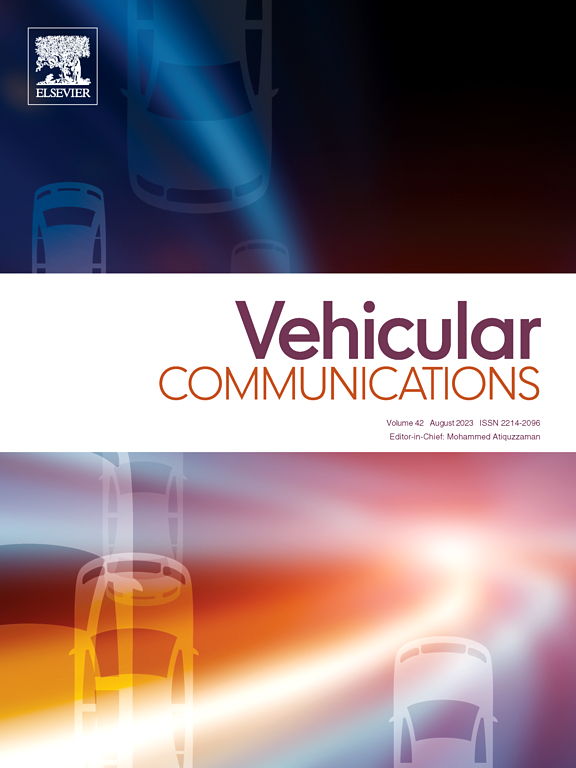基于深度学习的自主水下航行器信道叠加估计接收机结构
IF 6.5
2区 计算机科学
Q1 TELECOMMUNICATIONS
引用次数: 0
摘要
尽管自主水下航行器可以在恶劣和难以进入的海洋环境中完成复杂的任务,但它们面临着与恶劣的信道效应和有限的可用带宽相关的一些挑战,因此可靠的信道估计是实现鲁棒通信的关键任务。因此,为了跟踪信道效果,通常会为开销保留很大一部分带宽,这极大地降低了本已有限的带宽效率。在本文中,我们提出了一种基于深度学习的实信号正交频分复用(OFDM)方法,在不损失带宽效率的情况下准确跟踪信道效应。该方案采用离散哈特利变换产生真实信号调制,并在发送端采用统一神经网络(UNN)增加额外的数据包。在接收端,我们使用深度神经网络(DNN)结合信道估计和均衡来准确检测传输的信息数据。因此,我们联合训练UNN和DNN,以防止数据和飞行员之间的干扰,并有效地解决影响数据检测性能的因素。我们还在不牺牲任何子载波的情况下部署了载波频偏估计技术。因此,我们在不需要专用导频子载波和/或数据检测退化的情况下跟踪信道效应。实验结果表明,该方法具有较好的误码率、频谱效率和计算复杂度本文章由计算机程序翻译,如有差异,请以英文原文为准。
Deep learning-based receiver structure with superimposed channel estimation for autonomous underwater vehicles
Although autonomous underwater vehicles can achieve complex tasks in harsh and inaccessible marine environments, they face several challenges related to the harsh channel effects and limited available bandwidth, making reliable channel estimation crucial task for achieving robust communication. Therefore, to track channel effects, a significant portion of bandwidth is usually reserved for overhead, which dramatically reduces the already limited bandwidth efficiency. In this paper, we present a real signal orthogonal frequency division multiplexing (OFDM) method based on deep learning to accurately track channel effects without losing bandwidth efficiency. The proposed scheme adopts the discrete Hartley transform to produce a real signal modulation, and a unitary neural network (UNN) at the sending end to add extra packages. At the receiving end, we use a deep neural network (DNN) in conjunction with channel estimation and equalization to accurately detect the transmitted information data. Therefore, we jointly train both UNN and DNN to prevent interference between the data and pilot, as well as to address factors that impact data detection performance effectively. We also deploy the carrier frequency offset estimation technique without sacrificing any subcarriers. Consequently, we track channel effects without the need for dedicated pilot subcarriers and/or data detection degradation. The proposed method has a better bit error rate, spectral efficiency, and computational complexity than current benchmarks, as shown by both the simulation and the real experiments done in the sea over a distance of 300 m
求助全文
通过发布文献求助,成功后即可免费获取论文全文。
去求助
来源期刊

Vehicular Communications
Engineering-Electrical and Electronic Engineering
CiteScore
12.70
自引率
10.40%
发文量
88
审稿时长
62 days
期刊介绍:
Vehicular communications is a growing area of communications between vehicles and including roadside communication infrastructure. Advances in wireless communications are making possible sharing of information through real time communications between vehicles and infrastructure. This has led to applications to increase safety of vehicles and communication between passengers and the Internet. Standardization efforts on vehicular communication are also underway to make vehicular transportation safer, greener and easier.
The aim of the journal is to publish high quality peer–reviewed papers in the area of vehicular communications. The scope encompasses all types of communications involving vehicles, including vehicle–to–vehicle and vehicle–to–infrastructure. The scope includes (but not limited to) the following topics related to vehicular communications:
Vehicle to vehicle and vehicle to infrastructure communications
Channel modelling, modulating and coding
Congestion Control and scalability issues
Protocol design, testing and verification
Routing in vehicular networks
Security issues and countermeasures
Deployment and field testing
Reducing energy consumption and enhancing safety of vehicles
Wireless in–car networks
Data collection and dissemination methods
Mobility and handover issues
Safety and driver assistance applications
UAV
Underwater communications
Autonomous cooperative driving
Social networks
Internet of vehicles
Standardization of protocols.
 求助内容:
求助内容: 应助结果提醒方式:
应助结果提醒方式:


